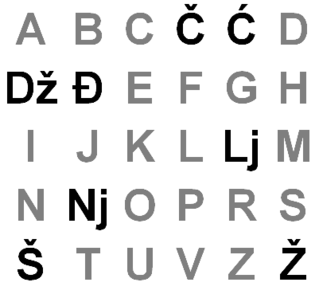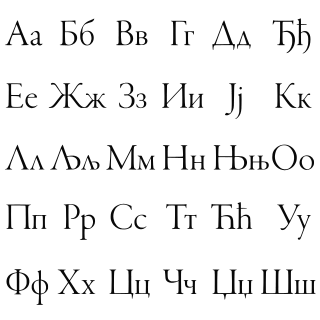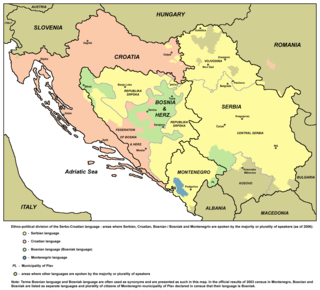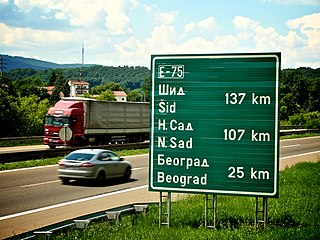 W
WSerbian is the standardized variety of the Serbo-Croatian language mainly used by Serbs. It is the official and national language of Serbia, one of the three official languages of Bosnia and Herzegovina and co-official in Montenegro and Kosovo. It is a recognized minority language in Croatia, North Macedonia, Romania, Hungary, Slovakia, and the Czech Republic.
 W
WGaj's Latin alphabet is the form of the Latin script used for writing Serbo-Croatian and all of its standard varieties: Bosnian, Croatian, Serbian, and Montenegrin.
 W
WThe Serbian Cyrillic alphabet is an adaptation of the Cyrillic script for the Serbian language, developed in 1818 by Serbian linguist Vuk Karadžić. It is one of the two alphabets used to write standard modern Serbian, Bosnian and Montenegrin varieties of Serbo-Croatian, the other being Latin.
 W
WAssociation for Serbian language and literature in Croatia is a non-profit professional organization that brings together scientists and technical workers engaged in studying and teaching of Serbian language and literature in Croatia. The association operates throughout Croatia and its headquarters is in Vukovar.
 W
WThe grapheme Čč is used in various contexts, usually denoting the voiceless postalveolar affricate consonant like the English ch in the word chocolate. It is represented in Unicode as U+010C and U+010D.
 W
WStandard Bosnian, Croatian, Montenegrin, and Serbian are different national variants and official registers of the pluricentric Serbo-Croatian language.
 W
WThe Declaration on the Common Language was issued in 2017 by a group of intellectuals and NGOs from Croatia, Bosnia and Herzegovina, Montenegro, and Serbia who were working under the banner of a project called "Language and Nationalism". The Declaration states that Croats, Bosniaks, Serbs and Montenegrins have a common standard language of the polycentric type.
 W
WThe Novi Sad Agreement was a document composed by 25 Serbian, Croatian and Bosnian writers, linguists and intellectuals to build unity across the ethnic and linguistic divisions within Yugoslavia, and to create the Serbo-Croatian language standard to be used throughout the country.
 W
WThe romanization of Serbian or latinization of Serbian is the representation of Serbian language using Latin letters. Serbian is written in two alphabets, the Serbian Cyrillic, a variation of Cyrillic alphabet, and Gaj's Latin, or latinica, a variation of the Latin alphabet. Serbian language is an example of digraphia.
 W
WThe grapheme Š, š is used in various contexts representing the sh sound usually denoting the voiceless postalveolar fricative or similar voiceless retroflex fricative /ʂ/. In the International Phonetic Alphabet this sound is denoted with ʃ or ʂ, but the lowercase š is used in the Americanist phonetic notation, as well as in the Uralic Phonetic Alphabet. It represents the same sound as the Turkic letter Ş and the Romanian letter Ș (S-comma).
 W
WSerbian studies or Serbistics is an academic discipline within Slavic studies which is focused on the study of Serbian language, literature, history and culture. Within Slavic studies it belongs to the South Slavic subgroup.
 W
WSlavonic-Serbian, Slavo-Serbian, or Slaveno-Serbian was a literary language used by the Serbs in the Habsburg Empire, mostly in what is now Vojvodina, from the mid-18th century to the first decades of the 19th century. It was a linguistic blend of Church Slavonic of the Russian recension, vernacular Serbian, and Church Slavonic of the Serbian recension.
 W
WA srbulјa, srbulje in plural, is a liturgical book written or printed in the Serbian recension of Old Serbian (Serbo-Balkanic), which was the written language of Serbs from the 12th century to the 1830s. The term was used for the first time by Vuk Karadžić in 1816 to differentiate liturgical books written in the Serbian recension from those written in the Russian recension, which gradually replaced srbulje at the beginning of the 19th century.
 W
WSrpski rječnik is a dictionary written by Vuk Stefanović Karadžić, first published in 1818. It is the first known dictionary of the reformed Serbian language.
 W
WThe term Greater Serbia or Great Serbia describes the Serbian nationalist and irredentist ideology of the creation of a Serb state which would incorporate all regions of traditional significance to Serbs, a South Slavic ethnic group, including regions outside modern-day Serbia that are partly populated by Serbs. The initial movement's main ideology (Pan-Serbism) was to unite all Serbs into one state, claiming, depending on the version, different areas of many surrounding countries.
 W
WLuko Zore was a Serbian philologist and Slavist from Dubrovnik. He was one of the leaders of the opposition to Austro-Hungarian Empire and Italy in Dubrovnik and a member of the Serb Catholic movement in Dubrovnik. Later in life he lived in Montenegro.